Automotive Sensors Market Size
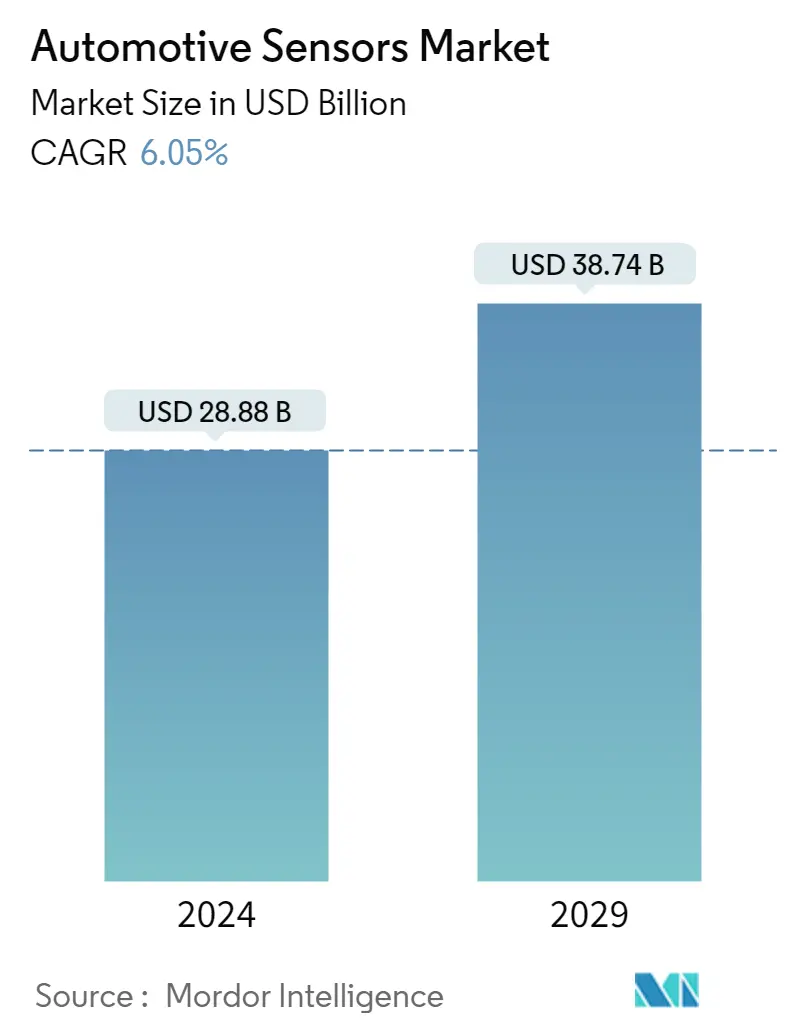
| Study Period | 2019 - 2029 |
| Market Size (2024) | USD 28.88 Billion |
| Market Size (2029) | USD 38.74 Billion |
| CAGR (2024 - 2029) | 6.05 % |
| Fastest Growing Market | Asia Pacific |
| Largest Market | North America |
Major Players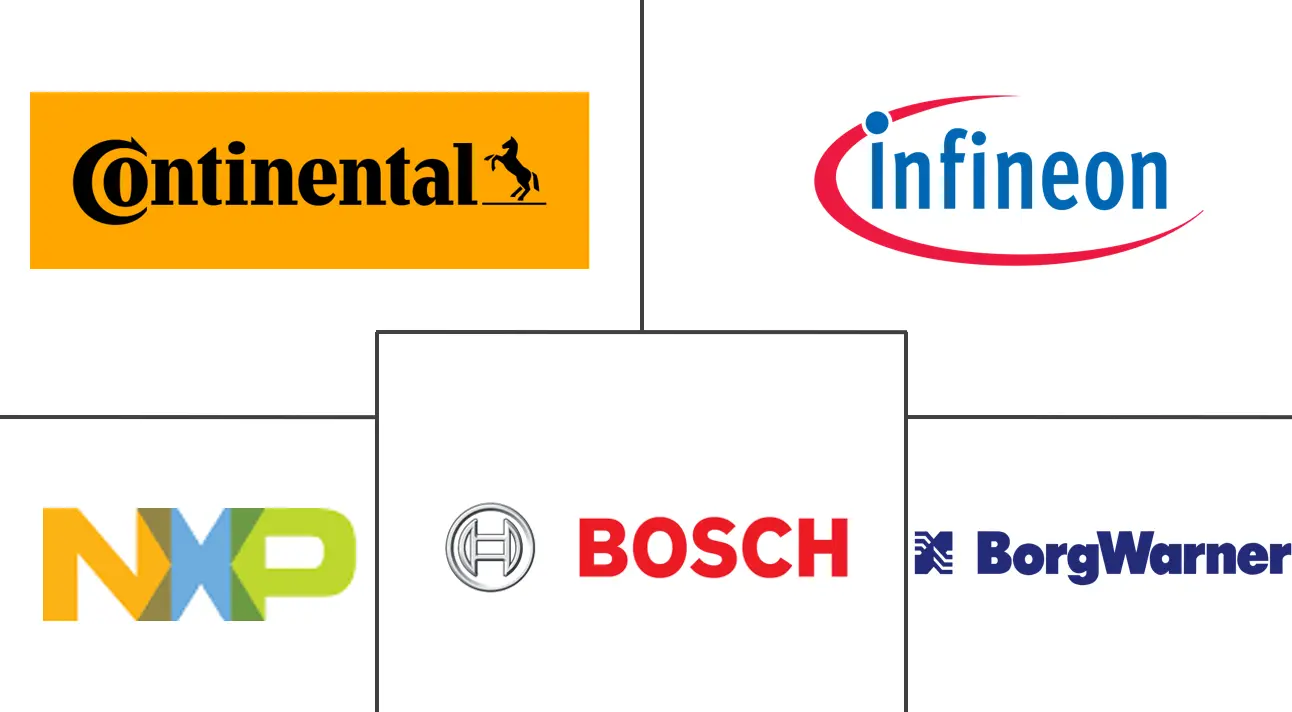
*Disclaimer: Major Players sorted in no particular order |
Automotive Sensors Market Analysis
The Automotive Sensors Market size is estimated at USD 28.88 billion in 2024, and is expected to reach USD 38.74 billion by 2029, growing at a CAGR of 6.05% during the forecast period (2024-2029).
The COVID-19 pandemic had a significant impact on the automotive industry, including the automotive sensors market. During the pandemic, many automotive manufacturing plants were shut down, which led to a reduction in the production of vehicles and consequently, a decrease in demand for automotive sensors. Additionally, the disruption in the global supply chain due to the pandemic resulted in a shortage of raw materials and components, which further affected the production of automotive sensors.
However, the market for automotive sensors is now recovering, and the demand for sensors is expected to increase as the automotive industry recovers. The pandemic has also accelerated the adoption of advanced driver assistance systems (ADAS) and autonomous vehicles, which rely heavily on automotive sensors. This is expected to drive the growth of the automotive sensors market in the coming years, as manufacturers increasingly incorporate these features into their vehicles.Over the long term, the automotive sensors market is expected to grow driven by the factors such as increasing demand for advanced driver assistance systems (ADAS) and autonomous vehicles.
Automotive sensors are components of a vehicle that are designed to detect, transmit, analyze, record, and display vehicle performance information from the vehicle's internal and external environments. The demand for automotive sensors is expected to rise significantly during the forecast period, owing to the growing popularity of vehicle automation and the growing demand for connected cars around the world.
Additionally, customers are also becoming more aware of new safety systems and technology, and they are increasingly selecting vehicles with improved safety features. Automotive manufacturers have been forced to equip their vehicles with features such as driver assistance systems, as passenger safety concerns have grown. Such factors are pushing the demand for sensors.
The use of several automobile sensors such as electric power steering (EPS) helps to provide the driver with extra safety benefits. Furthermore, the adoption of stringent fuel efficiency standards by government and international safety measures, are seen as major drivers for the expansion and development of advanced systems (such as EPS), which make extensive use of sensors.
The demand for electronic sensors for these position sensors in the automotive industry is expanding as a result of the increasing and continuous developments and breakthroughs in technology. As a result, the automotive sensor market is expected to increase significantly throughout the forecast period.
The automotive industry's recent shift in attention to technical developments such as electrification and autonomous driving has raised the demand for sensors. At the same time, the manufacturers' preference for integrating position sensors into vehicles suggests that the market will continue to grow.
Autonomous vehicles (especially level 4 and level 5) that feature self-driving systems generally process huge amounts of data to give feedback to the automotive system to drive smoothly clearing obstacles or performing turning maneuvers as per traffic signs. Due to this, it is expected that a greater number of sensors need to be incorporated into these types of vehicles, which is expected to drive the market for this segment.
Automotive Sensors Market Trends
Government Initiatives And The Growing Emphasis On Safer Automotive Systems Driving The Market
Around 1.24 million people die in road accidents each year on average around the world, half of whom are vulnerable road users like motorcyclists and pedestrians, and the other half are victims of side-impact collisions.
80% of cars sold worldwide, according to the World Health Organization (WHO), do not meet the essential safety requirements. The complete set of the seven most crucial regulations for auto safety has only been adopted by 40 nations.
The number of accidents has significantly increased, which has prompted end users to adopt better safety measures. In all first-world nations, injury and death rates have steadily decreased thanks to advancements in road and vehicle design.
Governments are concentrating on enforcing strict safety regulations and encouraging the adoption of various subsystems such as sensors in vehicles that enhance the aspects of safety because accident rates are still higher in some developing countries.
These factors are motivating automakers to add a number of safety sensors to their vehicles. Modern cars can now be found with cutting-edge security and safety features. Consumers are now more interested in choosing vehicles that are outfitted with better safety systems as a result of their increased concern for safety systems and technologies.
Additionally, a number of nations around the world have passed strict regulations governing vehicle pollution and fuel efficiency. Regulatory bodies including the National Highway Traffic and Safety Administration (NHTSA) in the United States, the International Council on Clean Transportation (ICCT) in Europe, and other organizations have adopted fleet-level requirements. These specifications set a minimum emission level that automakers must follow.
Based on the aforementioned points, the target market is expected to grow at a significant rate during the forecast period.
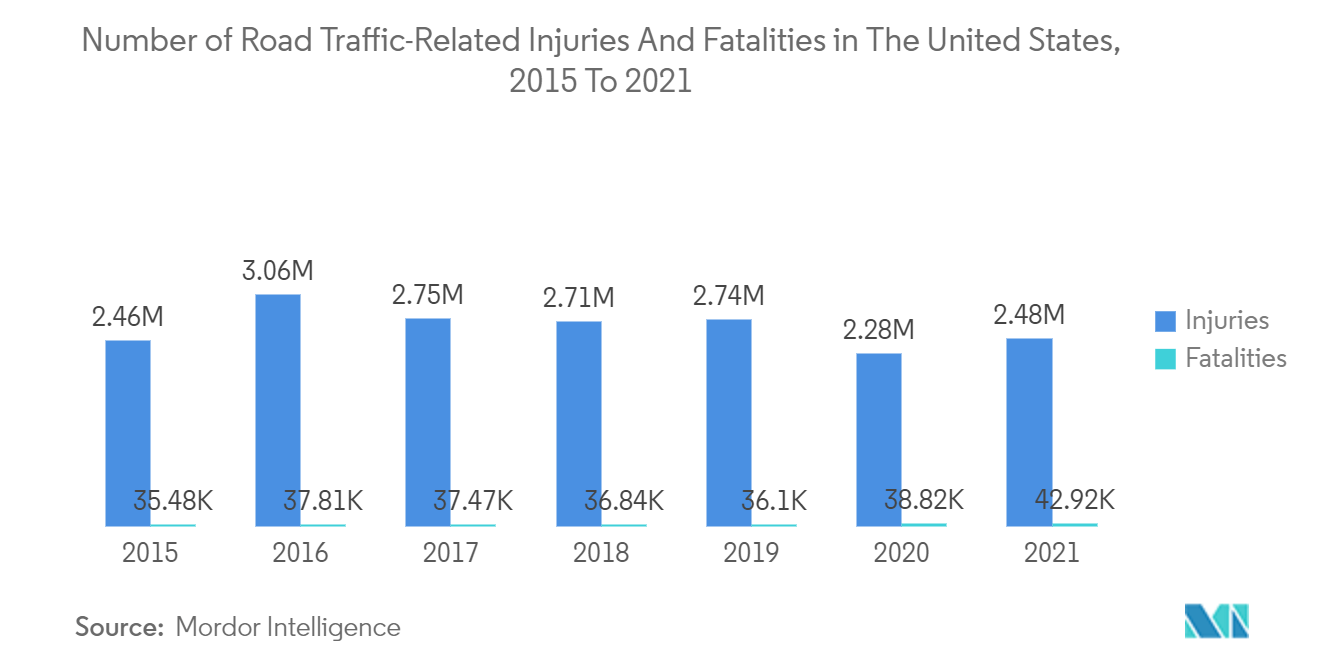
Asia-Pacific Dominates the market
Asia-Pacific held a major market share in terms of revenue during the forecast period. A rise in vehicle sales across the region is likely to increase the demand for sensors in the vehicle. The rise in demand for electric vehicles across the region is also propelling the growth of the market. The major presence of manufacturing industries across China, India, and Japan is creating market growth opportunities.
Due to increasing urbanization and stable economic conditions, automotive production in developing economies is growing faster than in developed economies. With an increase in the safety concerns among the consumers in the developing economies of India and the ASEAN countries, automobile manufacturers are incorporating more sensors in low-cost vehicles. It is expected to drive the demand for automotive sensors in the foreseeable future.
Some of the world's fastest-growing economies are located in the APAC region, with China and India leading the way. As a result, consumers in the middle class are more likely to purchase vehicles with advanced features like ADAS because they have more money to spend.
The adoption of advanced driver assistance systems (ADAS) and other safety features that rely on automotive sensors has been driven by initiatives implemented by numerous governments in the region to reduce traffic congestion and enhance road safety. With lower entry barriers than in other regions, the regulatory environment in many APAC nations is favorable for the adoption of advanced automotive technologies.
Additionally, some of the world's largest markets for electric vehicles (EVs) are located in the region. The fact that EVs heavily rely on sensors to control power delivery and monitor battery performance is driving regional demand for automotive sensors.
Hence, APAC region is the most important market for automotive sensors because of its high demand for vehicles, rapidly expanding economy, encouraging government initiatives, favorable regulatory environment, and growing emphasis on electric vehicles.
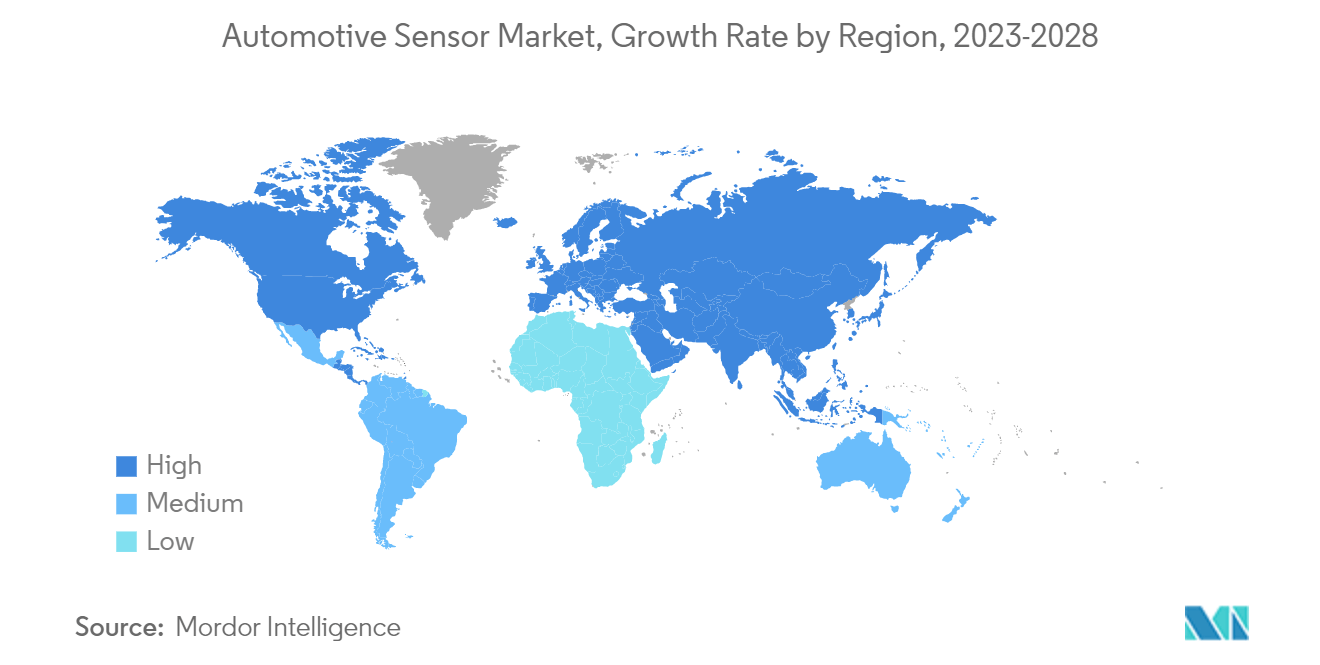
Automotive Sensors Industry Overview
Some of the major players in the studied market include Continental AG, Robert Bosch GmbH, Borgwarner Inc, Infineon Technologies, NXP Semiconductors, Denso Corporation, and Others In addition to these active product innovations, collaborations, etc., the market is experiencing significant growth due to the growing partnership between major players. expected to give the market a good outlook over the forecast period. For instance,
- In January 2023, NXP Semiconductors N.V. (NXP) announced its participation in the early development phases of new VinFast automotive projects at CES 2023. VinFast will strive to leverage NXP's processors, semiconductors, and sensors, while NXP will provide top-tier solutions to speed time-to-market. The joint expert collaboration will focus on developing solutions for designing and producing cutting-edge EVs based on NXP's recognized reference assessment platforms and software layers.
Automotive Sensors Market Leaders
-
Continental AG
-
NXP Semiconductors NV
-
Robert Bosch GmbH
-
Infineon Technologies AG
-
BorgWarner Inc
*Disclaimer: Major Players sorted in no particular order
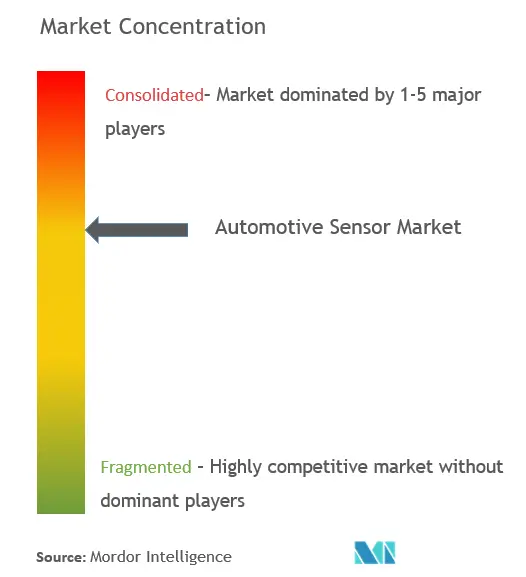
Automotive Sensors Market News
- December, 2022: Continental AG (Continental) announced that it will show-off modules and sensors created exclusively for electromobility. Continental will debut its Advanced Driver Assistance Systems (ADAS) which has been integrated into the "CV3" SoC (System on Chip) family with artificial intelligence (AI) from semiconductor startup Ambarella.
- November, 2022: Infineon Technologies AG announced the addition of the latest XENSIV TLE4971 family to its current sensor series for automotive applications. Infineon's XENSIV TLE4971 devices offer precise magnetic current sensing based on proprietary temperature and stress compensation without the harmful effects of magnetic cores caused by hysteresis or saturation effects.
- March, 2022: CTS Corporation announced the acquisition of TEWA Temperature Sensors SP. Zo.o. and its subsidiaries. The company is a strong complement to CTS's temperature sensing platform and will expand CTS's presence in Europe.
Automotive Sensors Market Report - Table of Contents
1. INTRODUCTION
- 1.1 Study Assumptions
- 1.2 Scope of the Study
2. RESEARCH METHODOLOGY
3. EXECUTIVE SUMMARY
4. MARKET DYNAMICS
- 4.1 Market Drivers
- 4.2 Market Restraints
-
4.3 Industry Attractiveness - Porter's Five Forces Analysis
- 4.3.1 Threat of New Entrants
- 4.3.2 Bargaining Power of Buyers/Consumers
- 4.3.3 Bargaining Power of Suppliers
- 4.3.4 Threat of Substitute Products
- 4.3.5 Intensity of Competitive Rivalry
5. MARKET SEGMENTATION
-
5.1 Type
- 5.1.1 Temperature Sensors
- 5.1.2 Pressure Sensors
- 5.1.3 Speed Sensors
- 5.1.4 Level/Position Sensors
- 5.1.5 Magnetic Sensors
- 5.1.6 Gas Sensors
- 5.1.7 Inertial Sensors
-
5.2 Application
- 5.2.1 Powertrain
- 5.2.2 Body Electronics
- 5.2.3 Vehicle Security Systems
- 5.2.4 Telematics
-
5.3 Vehicle Type
- 5.3.1 Passenger Cars
- 5.3.2 Commercial Vehicles
-
5.4 Geography
- 5.4.1 North America
- 5.4.1.1 United States
- 5.4.1.2 Canada
- 5.4.1.3 Mexico
- 5.4.1.4 Rest of North America
- 5.4.2 Asia-Pacific
- 5.4.2.1 China
- 5.4.2.2 Japan
- 5.4.2.3 India
- 5.4.2.4 South Korea
- 5.4.2.5 Rest of Asia-Pacific
- 5.4.3 Europe
- 5.4.3.1 Germany
- 5.4.3.2 United Kingdom
- 5.4.3.3 France
- 5.4.3.4 Rest of Europe
- 5.4.4 Rest of the World
- 5.4.4.1 Brazil
- 5.4.4.2 United Arab Emirates
- 5.4.4.3 Other Countries
6. COMPETITIVE LANDSCAPE
- 6.1 Vendor Market Share
-
6.2 Company Profiles
- 6.2.1 DENSO Corporation
- 6.2.2 Infineon Technologies AG
- 6.2.3 Robert Bosch GmbH
- 6.2.4 Texas Instruments Inc.
- 6.2.5 Sensata Technologies Holding PLC
- 6.2.6 Aptiv PLC (Delphi Automotive)
- 6.2.7 CTS Corporation
- 6.2.8 Maxim Integrated Products Inc.
- 6.2.9 NXP Semiconductors NV
- 6.2.10 Analog Devices Inc.
- 6.2.11 Continental AG
- 6.2.12 Littelfuse Inc.
- 6.2.13 Hitachi Automotive Systems Americas Inc.
- *List Not Exhaustive
7. MARKET OPPORTUNITIES AND FUTURE TRENDS
** Subject To AvailablityAutomotive Sensors Industry Segmentation
Automotive sensors are used to gather information about the vehicle's surroundings, such as its speed, location, and environment, and then send this information to the vehicle's onboard computer system to make decisions.
The Automotive Sensors Market is Segmented by Type (Temperature Sensors, Pressure Sensors, Speed Sensors, Level/Position Sensors, Magnetic Sensors, Gas Sensors, and Inertial Sensors), Application (Powertrain, Body Electronics, Vehicle Security Systems, and Telematics), Vehicle Type (Passenger Cars and Commercial Vehicles), and By Geography (North America, Europe, Asia-Pacific, and Rest of World). The report covers the market size in value (USD billion) for all the above segments.
| Type | Temperature Sensors | |
| Pressure Sensors | ||
| Speed Sensors | ||
| Level/Position Sensors | ||
| Magnetic Sensors | ||
| Gas Sensors | ||
| Inertial Sensors | ||
| Application | Powertrain | |
| Body Electronics | ||
| Vehicle Security Systems | ||
| Telematics | ||
| Vehicle Type | Passenger Cars | |
| Commercial Vehicles | ||
| Geography | North America | United States |
| Canada | ||
| Mexico | ||
| Rest of North America | ||
| Geography | Asia-Pacific | China |
| Japan | ||
| India | ||
| South Korea | ||
| Rest of Asia-Pacific | ||
| Geography | Europe | Germany |
| United Kingdom | ||
| France | ||
| Rest of Europe | ||
| Geography | Rest of the World | Brazil |
| United Arab Emirates | ||
| Other Countries |
Automotive Sensors Market Research FAQs
How big is the Automotive Sensors Market?
The Automotive Sensors Market size is expected to reach USD 28.88 billion in 2024 and grow at a CAGR of 6.05% to reach USD 38.74 billion by 2029.
What is the current Automotive Sensors Market size?
In 2024, the Automotive Sensors Market size is expected to reach USD 28.88 billion.
Who are the key players in Automotive Sensors Market?
Continental AG, NXP Semiconductors NV, Robert Bosch GmbH, Infineon Technologies AG and BorgWarner Inc are the major companies operating in the Automotive Sensors Market.
Which is the fastest growing region in Automotive Sensors Market?
Asia Pacific is estimated to grow at the highest CAGR over the forecast period (2024-2029).
Which region has the biggest share in Automotive Sensors Market?
In 2024, the North America accounts for the largest market share in Automotive Sensors Market.
What years does this Automotive Sensors Market cover, and what was the market size in 2023?
In 2023, the Automotive Sensors Market size was estimated at USD 27.23 billion. The report covers the Automotive Sensors Market historical market size for years: 2019, 2020, 2021, 2022 and 2023. The report also forecasts the Automotive Sensors Market size for years: 2024, 2025, 2026, 2027, 2028 and 2029.
What are the key drivers behind the growth of the Automotive Sensors Market?
The major factors driving the growth of Automotive Sensors Market are: a) Increasing demand for safety and comfort features in vehicles b) Advancements in sensor technology c) Rise of autonomous vehicles
What are the emerging trends in Automotive Sensor Technology Market?
Emerging trends in the Automotive Sensor Technology Industry are: a) Sensor fusion (combining data from multiple sensors) b) Integration with the Internet of Things (IoT) c) Sensor-based driver monitoring systems represent potential future advancements
Automotive Sensors Industry Report
The Global Automotive Sensors Market is on a significant upswing, fueled by the rising demand for vehicle electrification, advancements in autonomous driving, and an increased focus on safety features. Sensors in vehicles are pivotal for enhancing performance, safety, and comfort, marking them as essential in modern automobiles. This growth is propelled by the surge in vehicle electrification and the adoption of advanced driver assistance systems (ADAS), which heavily depend on sensors in automotive applications. The market also sees opportunities in aftermarket services for sensor-based solutions in vehicles lacking initial tech integration. Challenges like developing high-performance sensors for extreme conditions spur innovation, with the market aiming for compact, energy-efficient, and cost-effective sensors. Segmented by sensor types, vehicle types, and applications, the Asia Pacific region leads in growth due to government initiatives promoting sensor adoption in ADAS and EVs. According to Mordor Intelligence™ Industry Reports, the automotive sensors market is poised for robust growth, with detailed analysis available in a free report PDF download, covering market share, size, revenue growth rate, and a forecast outlook.



